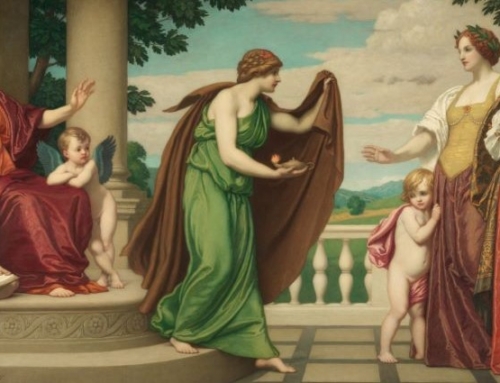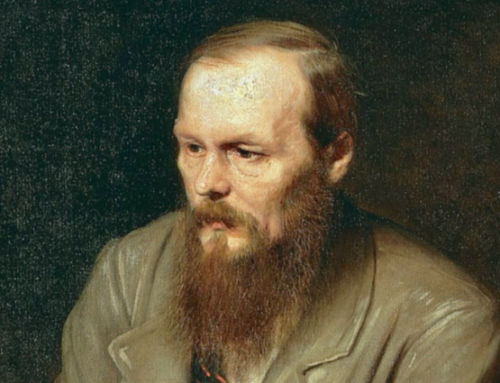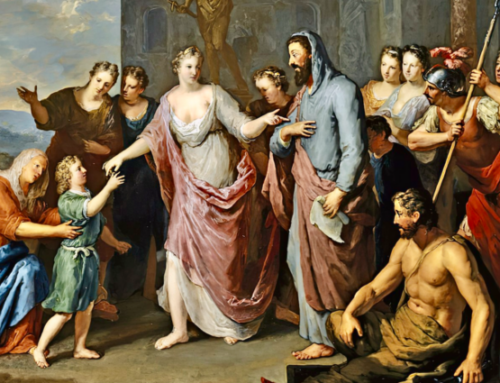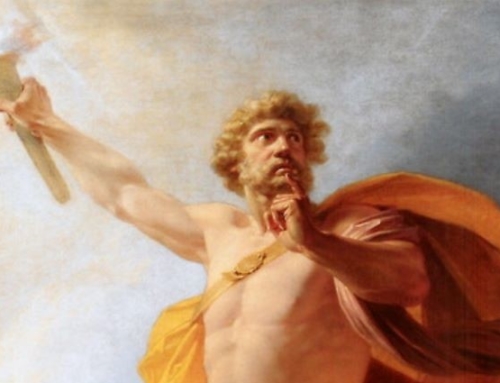Through their art, Romantic painters sought to restore the sacramental bond between the heavenly and the human. And among these artists, none was more focused on the lost liturgy of Western culture as Caspar David Friedrich, whose paintings—almost exclusively concerned with the subject of landscapes—at first glance seem to have little or nothing to do with man, let alone man’s relationship to the divine.
The Romantic movement of the early nineteenth century was more than historians often understand it to be. With an unparalleled subjectivity and exuberance, it is usually seen as a reaction to the rationalism of the so-called Enlightenment. From the crescendos of Beethoven to the lyrics of Byron, it sought the transformation of a culture constrained, as proponents saw it, by eighteenth-century conventions of counterpoint and the couplet. However, as Romanticism elevated sentiment it also advanced an equally ambitious effort to secure a transcendent anchor for its cult of feeling. Advocates were painfully, even desperately aware that a yawning chasm had opened between the world and the source of its transformation, heaven. They were secularists to the core, but they nevertheless realized that the impasse of modernity was an ironic outcome of secularization.
Indeed, since the quattrocento secularization had displaced what during the first millennium had been a paradisiacal culture shaped by liturgy. Through the Christian sacraments the world had been spiritually transformed by being directed toward the kingdom of heaven. The Incarnation assured the West that a civilization with a supporting culture that directed its members toward the heavenly transformation of the world was possible because God had become human and, by doing so, had united earth to heaven. This paradisiacal culture was thus founded on a transformational imperative. It was expressed by a concept known as “orientation.” Ancient Christian worship, based as it was on the scriptures, directed man toward the geographical “east” (oriens in Latin). It opened to him his true homeland, paradise (Gen. 2:8). But the liturgical principle of heavenly orientation gave way, after the quattrocento, to a very different, utopian vision of culture. Modernity re-oriented the West away from paradise toward a spiritually untransformed world—one that Augustine had dismissively once called the saeculum. For traditional Christianity, then, secularization was not just an act of reorientation. It was an act of dis-orientation. After all, man was made not for a spiritually untransformed world but for paradise. Ironically, for the secularly-minded Romantics the loss of a liturgical culture was likewise seen as a cause of cultural decline. Though invested in the saeculum (consider the agnosticism of Brahms or the atheism of Percy Shelley), they nevertheless sought innovative but ultimately counterfeit ways of restoring a culture of transcendence. This led them toward what can be called a reliturgification of the West.
For the deists of the eighteenth century, man’s autonomous relationship to a “watchmaker god” promised to return the West to pre-Christian pagandom. In the realm of painting, for instance, the regression from the Virgin Mary to Venus initiated during the Renaissance by the likes of Titian reached cheerful completion in the boudoir imagery of Francois Boucher. But as artists lost interest in transcendence, the artwork lost its power to transform the world. Jacques-Louis David’s work in this sense is an early effort at correction. The Death of Socrates, with its protagonist pointing toward heaven in the company of twelve disciples, provides a hint at what Romanticism would soon bring: an effort to mimic Christianity and reunite the world with heaven. David’s Death of Marat makes an even more self-conscious allusion to the liturgical art of Christendom as the dying revolutionary peacefully assumes the posture of the pieta, the ultimate image of holiness for painters and sculptors since Michelangelo. Yet David remained a deist. His works never suggest a sacramental bond between the heavenly and the human.
Romantic painters sought to correct this. And among them, none was more focused on the lost liturgy of Western culture as Caspar David Friedrich. This is particularly interesting because as a painter he was almost exclusively concerned with the subject of landscapes. At first glance, his paintings seem to have little or nothing to do with man, let alone man’s relationship to the divine.
But they did, as Romanticism considered the natural world a source of transcendence. Romantics believed that a sublime landscape—whether a waterfall, a moonrise, or a mountain—is indwelt by divinity. The tendency here was toward pantheism, and it provided a refreshing if spiritually incoherent alternative to deism. Separated from traditional Christianity, modern man turned to nature for sacramental communion. Wordsworth turned to daffodils and the majesty of England’s Lake Country. Beethoven turned to the experiences of the countryside in works like the Pastoral Symphony. Mary Shelley had Doctor Frankenstein, after witnessing the catastrophic consequences of his actions, turn for consolation to the lofty Alps in pantheistic prayer. Friedrich went a step further. He approached nature the way a first-millennium member of the West would have approached a temple. Just as icons had once provided Christians with “windows into heaven,” he believed landscapes could orient the pantheistic believer toward the source of the world’s salvation. Painting would once again become a liturgical art, and it would leave man in full possession of the saeculum.
The most explicit effort to train contemporaries in the worship of nature is Friedrich’s Woman before the Rising Sun (1818). As the title suggests, it is not merely a landscape painting. Dawn does not occur on its own, but as the inspiration of worship. As the sun reveals itself over a distant mountain peak, sending shafts of light through the atmosphere, a lone woman stands in worship of it. With her back to the viewer, her arms are opened outward in pious supplication. Friedrich appears to have had in mind the ancient Christian posture of the orans found in iconography since the time of the Roman catacombs. What is perhaps even more evocative of liturgical imagery is the fact that, facing the sunrise, she is also therefore facing the east. She is oriented. The source of transcendence is not the Christian kingdom of heaven, however, but nature.
Friedrich produced numerous compositions featuring a human figure (or figures) looking away from the viewer toward a transcendent landscape. This device was in fact his trademark, though it was an adaptation of what had long been known as a Rückfigur, or “back figure.” Like the liturgical celebrant standing in front of a congregation, Friedrich’s Rückfigur provided a model of worship to viewers, and with them the West. Man once again stands as high priest before the majesty of the divine, supplicating heaven in an act that brings about the transformation of the world.
Even more successful than Woman before the Rising Sun was Friedrich’s Wanderer above the Sea of Fog (1818). It is one of the most widely reproduced monuments of the Romantic movement. Instead of using a horizontal register (conventional for a landscape), it uses the vertical register of a portrait to emphasize the Rückfigur’s heavenly orientation. A man is dressed in an urbane costume with a white collar and a cane, contrasting the untamable sublimity of nature. Before him mists swirl wildly upward to encompass the mountaintop he has ascended. The breathtaking scene can be likened to that of Moses atop Mount Sinai during one of the Old Testament’s most memorable encounters between man and God. In this case, however, divinity is not personal but diffused within nature.
Even more liturgified is the landscape known as Cross in the Mountains. In this case Friedrich actually intended the work to be used in worship insofar as it was commissioned to stand atop the altar of a private chapel. As such, no Rückfigur with back to the viewer was needed. Instead, the artist breaks every historical convention by making the image of the Crucifixion a celebration of nature. Like Woman before the Rising Sun, it is oriented toward the sun. But in this case the sun is setting in the west. Shafts of its light again spread out from behind a mountain at the center. That mountain is Golgotha, though rather than the Judean desert the topography is an outcropping within a lush forest. The cross on which Jesus hangs is itself radically different than that of any previous Crucifixion scene. As tall and slender as the fir trees surrounding it, the base is overgrown with vines. Christ himself is turned away from the viewer (though not so far as to represent a Rückfigur), a reminder of the Romantics’ secularistic preference for an impersonal deity. His body is almost indistinct before a still and majestic and almost serene evening atmosphere.
Serenity was in fact a state of mind encouraged by the imagery of Christ’s Passion during the first millennium. Long before Giotto made emotional reactions the goal of liturgical art (his Padua Lamentation, coincidentally, also employed a Rückfigur to achieve its effect), iconographers represented Jesus on the cross or recently lowered from it in a way that precluded rampant anxiety. The human body of the savior was depicted beautifully—well-formed and with a minimum of bruising—to emphasize its deification. Even in the death of Jesus, earth was visibly united with heaven. The Renaissance changed this. As the Crucifixion became increasingly shocking and even ghastly, culminating in Grunewald’s notorious Isenheim Altarpiece, Western liturgical art began to lose its ability to transform the world. In reaction, Western art turned to a deliturgified saeculum.
In his classic study Natural Supernaturalism, M.H. Abrams described early Romanticism as an effort to infuse the cosmos with a divine presence, to restore to the West the communion it once enjoyed with a transcendent God. The movement reversed the effects of eighteenth-century deism, whose watchmaker god had little interest in man and the world he inhabited. But as Abrams noted, as much as Romanticism hoped to supernaturalize nature it could not do so without a “secularization of inherited theological ideas and ways of thinking.”[*] Caspar David Friedrich’s landscapes show that the Romantic reliturgification of the West was a brilliant but ultimately disoriented effort to recover Christendom’s transformational imperative using secular rather than truly sacramental means.
[*] M.H. Abrams, Natural Supernaturalism: Tradition and Revolution in Romantic Literature (New York: W.W. Norton, 1971), 12.
The Imaginative Conservative applies the principle of appreciation to the discussion of culture and politics—we approach dialogue with magnanimity rather than with mere civility. Will you help us remain a refreshing oasis in the increasingly contentious arena of modern discourse? Please consider donating now.
The images Cross in the Mountains, Woman before the Rising Sun, and Wanderer above the Sea of Fog are in the public domain, courtesy of Wikimedia Commons.










Leave A Comment